History of the Canal du Midi at Carcassonne
Maps - CEVNI - Canal du Midi history
Did you know that the Canal du Midi has not always gone through Carcassonne !!!
Pierre-Paul Riquet (1609 - 1680)
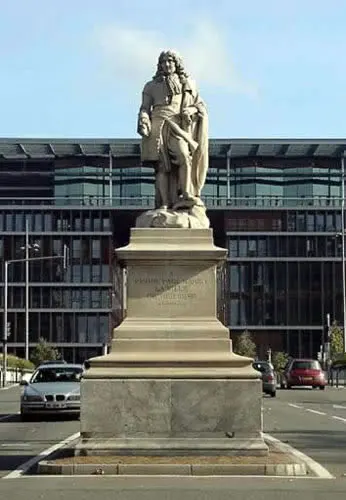
The Canal du Midi is, quite justifiably, widely acclaimed as a masterpiece of engineering and ingenuity. Its creator, Pierre-Paul Riquet (1609* - 1680) had to overcome many financial difficulties, withstand considerable political interference and also resolve a range of logistical setbacks in order to complete the project and it was a tragedy that he died before he could see it completed. **Pierre-Paul Riquet was born in Beziers and 1609 is the commonly accepted year of his birth as his Death Certificate gave his age at death as 71 but no Birth Certificate has ever been discovered.
In researching the history of the Canal du Midi there are a number of obstacles to negotiate. The name of the canal itself has changed - it was originally the Canal Royal de Languedoc and was heavily financed by the French King, amongst others. After the revolution of course, the "Royal" connection was no longer appropriate within the new republic and Bonaparte issued a decree dated 10 March 1810, which modified the rights of ownership of the canal and created la Société du Canal du Midi - thus the canal, was renamed. In addition to the change of name of the canal, some of the locks have been renamed and in certain cases, locks that became disused and bypassed had their names transferred to different locks which can cause some head scratching when looking at old maps!
As an introduction to this article, let me pose the question. "How many of today's hire boats happily head off towards Carcassonne without realising that the original canal, as built by Riquet, bypassed the city and it was nearly 130 years before the Port of Carcassonne was opened?" The obvious answer to the question is probably not very many at all. After all, it is now very difficult to see where the changes have occurred, particularly as the "new locks" that needed to be constructed to traverse Carcassonne were built to the same shape and dimensions as those built by Riquet originally.
Originally Pierre-Paul Riquet had planned for the Canal du Midi to bypass Carcassonne altogether.
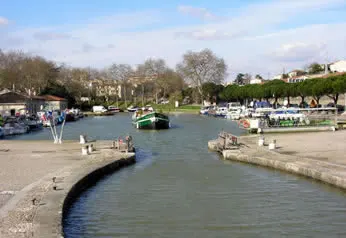
Instead it would follow the path round the northern side of the city of the small, meandering River Fresquel, which eventually flows into the River Aude near to the village of Montredon. In his original plans, faced with a variety of geographical and financial limitations, Riquet had intended to canalise much of the Fresquel and, thereby, create a route that had the potential to save a considerable amount of money on digging a channel from scratch.
Despite his original intentions, Riquet negotiated in 1670 to route the canal through to Carcassonne on condition that the town elders met the considerable costs involved. Riquet had calculated that a revised routing of the canal via Carcassonne would add over an additional 2 kilometres to his original route and he had requested an investment of approximately £100,000. The leaders of Carcassonne could not (and/or would not) raise this amount of money and so Riquet continued with his original plan. With the benefit of hindsight, it was a decision that was very quickly regretted by the Carcassonne authorities as they saw the prosperity the canal brought to those areas it passed through, particularly Castelnaudary and they campaigned and petitioned for the canal to be rerouted to the town.
Whilst Pierre-Paul Riquet continued with his original route, it soon transpired that utilising the Fresquel riverbed was fraught with problems and eventually, he had to dig virtually the full route around Carcassonne. One disadvantage of this modified route is that it still required an eventual crossing of the Fresquel to be made "on the level". Once this crossing was created it caused navigational problems, particularly during periods of flood when silt and debris swept into the canal. A complex system of raised causeway allowed the towpath to cross the junction with the Fresquel but nothing of it remains.
Marquis de Vauban (1633 - 1707) was the leading military engineer of his age and in 1686 King Louis XIV sent him to survey the full canal and make recommendations for improvements. Amongst these recommendations, Vauban proposed constructing an "Arm" from the existing canal to a new port at Carcassonne but his proposals were not immediately acted upon. The ongoing difficulties associated with the crossing of the Fresquel and the continuing desire to link the canal to Carcassonne, eventually led to a much broader proposal to totally reroute the canal through the town and out the other side. This plan incorporated the construction of a new crossing of the River Fresquel by means of an aqueduct.
The plans for the new "cut", known originally as the Canal de Carcassonne, were finally accepted in 1786 with work commencing the following year although, following disruption during the revolution, it was not until 1810 that the new line was inaugurated.
Original Canal du Midi route

Nolin, Jean-Baptiste (1657-1708). Le canal royal de Languedoc. Gallica - Bibliothèque nationale de France.
Epanchoir de Foucaud
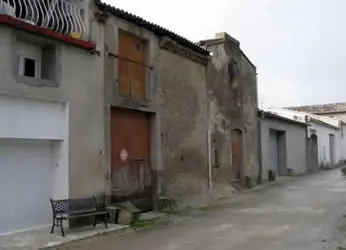
To the west of Carcassonne, between PK 101 and PK 1O2, is situated the Epanchoir de Foucaud - an epanchoir is basically a spillway, normally controlled by sluices, that allows excess water in the canal to be run off. Close to this spillway, the original line of the canal descended through a triple staircase lock (named Foucaud) and headed in a northeasterly direction towards the River Fresquel. A short distance beyond the Foucaud locks, a Port was created where goods could be transshipped to and from packhorses and carts for transport to and from Carcassonne. This collection of buildings, known as Port Foucaud, included a Chapel, Office and storage facilities.
After Port Foucaud the canal then ran in an easterly direction following a route through open countryside between the river and the northern edge of what are now the existing City extremities. The canal descended again through a double staircase lock known as Villaudy (but spelt as Villaudi in some documents) before crossing the Fresquel on a level, downstream of the Fresquel single lock.
Traces of the original line of the Canal du Midi.
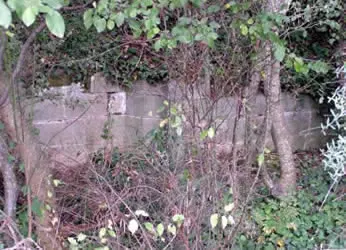
Although considerably overgrown, it is still possible to find traces of the original line of the canal as it bypassed Carcassonne. The area around the Fresquel locks has seen some considerable change and it takes both concentration and imagination to conjure up a picture of what was here originally. Initially, try and picture yourself traveling upstream towards Carcassonne today and, as you approach PK 109, you will pass under a small road bridge.
To your right is the entrance of a rigole (feeder channel) that supplements the canal with water from the River Fresquel and to your left is another, much older double arched stone bridge, which is linked at an angle to the bridge under which you have just passed. The arches of this older bridge are significantly different in size and the smaller arch is only visible from the shore. Depending on which source or map you consult, this bridge was known as either Pont Rouge or Pont de Conques although the modern Industrial Estate just beyond the Fresquel locks is known as the Zone Industrial (ZI) Pont-Rouge.
The Fresquel feeder
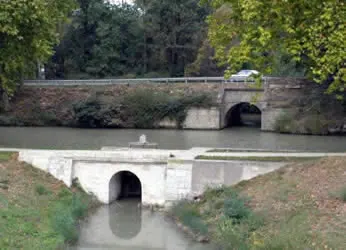
The feeder channel to your right is at the point of the original line of the Fresquel. On the left of the canal at this point was a large (over 100 metres long) rudimentary levee with a number of epanchoirs to maintain the level of the water in the canal and it incorporated a raised walkway running along its length to carry the towpath over the river. The effect of this "damming" of the river raised its level and to the right of the canal, a large lake was created to absorb some of the variations. The Fresquel effectively flowed into and across the canal, then ran off back into the original riverbed and passed under the stone bridge on its route towards the River Aude.
In the picture, the car is passing over the inlet from the Fresquel feeder. On this side of the canal are a sluice and the original line of the River Fresquel.
Ahead of you now are the Fresquel locks complex.
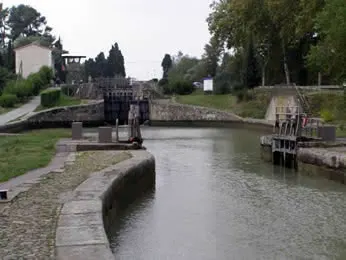
Looking through the gates of the Fresquel Single Lock towards the newer Fresquel Double Staircase Lock. All of these locks are controlled from the "Watchtower". The small basin between the locks is the point at which the original line veered to the right.
The first, a single lock, is original and from here the canal veered to the right heading on its original route around Carcassonne. Just after the first single lock is a small basin and then the Fresquel double staircase lock that raises the canal by 5.66 metres to subsequently cross the River Fresquel on the Pont Canal de Fresquel. This structure carries the canal, towpath and road over the Fresquel on 3 arches. At 43.85 metres in length and 26.33 metres in width it is an impressive structure and was built between 1802 and 1810. The Fresquel double lock and the 2 single locks beyond (St Jean and Carcassonne) are not the work of Riquet although, as previously stated, the locks are built to his original design and dimensions.
The Pont Canal du Fresquel.
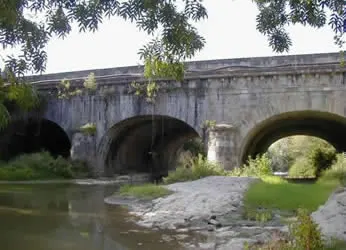
The Pont Canal du Fresquel was built between 1802 and 1810, it is 43.85 metres in length spanning 3 arches and carries the new line of the Canal towards Carcassonne.
The new route of the Canal du Midi through Carcassonne required a number of major works and improvements in the area of the Fresquel locks. The River Fresquel itself was diverted onto a new line, passing under the new aqueduct and following a new route to the Aude and its hazardous and problematic crossing on the level was removed.
The old lake that had been created on the original Fresquel riverbed disappeared and the original line of the Fresquel was reduced in width and converted into a rigole. This feeder draws water from the river upstream of the Fresquel double at the Barrage de Chaux. The Barrage is close to the elegant old road bridge, the Pont de Fresquel.
This is the old road bridge over the Fresquel River.

Looking through the main, central arch, you can just see the sluices that allow water into the rigole. Note how the level of the river is well below the sluices, this photograph was taken in October 2007.
When the new 7 Km line of the canal that traversed Carcassonne and re-joined the original canal near to the Epanchoir de Foucaud (spillway of Foucaud) was completed, the original line was fairly quickly abandoned.